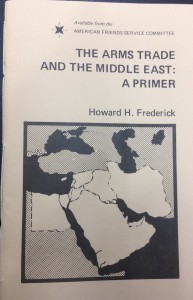I am a senior Political Science Major, with minors in history and human rights. I initially chose my internship with the Dodd Archives because of its unique holdings. Most famously, the Nuremburg Trial Papers have been examined by many scholars for the fundamental groundwork they laid for human rights advocates. As one of the youngest members of the millennial generation and one of the last children to remember watching the 9/11 attacks on television I feel a certain draw towards researching the Middle East. Furthermore, my involvement with the human rights program at the university has given me a distinctive outlook on international foreign involvement in the Middle East. The Arab Spring began while I was in my first year of undergraduate studies, and has continued to make headlines since. As a historian and political scientist I have noticed that the American population seems to have a short-term memory when it comes to American involvement abroad. I will attempt to remedy this phenomenon through my posts by concentrating on linking historical to contemporary international involvement in the region.
Towards the end of the 1970’s the Middle East was going through a transformative period. This transformation was facilitated principally by the unrestricted and indiscriminate selling of weapons from the United States and NATO allies and USSR into the region. The Arms Trade of the Middle East: A Primer, by Howard H. Frederick published in 1977 extensively details the arms trade between Western and Soviet regimes to the authoritarian monarchs of the Middle East.
The underlying problem with the arms trade outlined by Frederick in the periodical is the military industrial complex in place during the Cold War produced a need for selling American weapons around the world to benefit domestic defense contractors. One candid figure quoted by Frederick estimated the sale of one jet fighter earns back more dollars than the sale of one thousand automobiles. However, once weapons are sold to allies or enemies alike they become commodities on the world market. The following excerpt illustrates the totalizing system of the global commodity arms exchange:
Jordan sold American fighter aircraft and defense systems as well as British tanks to South Africa. British arms bought in New Zealand are being used by Irish Republican Army against British soldiers. US arms left over from Vietnam were sold at a Bangkok auction to a French dealer who in turn sold them to the rightist militias in Lebanon. US arms sold to Israel were used by Lebanese rightwing militias.
-Christian Science Monitor, August 25, 1976
Frederick places emphasis on greater accountability regarding the trading of arms to foreign allies with a goal of eventual disarmament. Although some may argue, that the arms supplier gains political leverage with the purchasing country. I would argue that policy has historically produced inconsistent results among allies especially within the region. The example which stands out most during this period was the American government’s foreign policy relations with the Shah of Iran. From 1974-1976 the United States sold an unprecedented $16.9 billion in governmental and commercial arms; the primary recipients of which were the Saudi and Iranian monarchs. In addition to lack of accountability regarding control on arms deals, there were also economic and social consequences felt by developing countries receiving foreign made arms. Military budgets disproportionately burden local economies and delay construction of important infrastructure projects. Furthermore, military spending increased inflation on consumer goods because they exerted pressure on prices without producing economically useful products for civilians.
While Fredrick focuses primarily upon arms sales to the Middle East it is important to note that foreign military and defense personnel played an increasingly important role in the region. American and British military advisors, soldiers, and private citizens were involved in armed conflicts within the region during this time. Mercenaries: “Counter insurgency” in the Gulf by Fred Halliday published in 1977 describes mostly British and American involvement in the region. The British government had the historical experience of creating the world’s largest colonial empire. Halliday explains that, by the time decolonization took place the British military had become experts in counter-insurgency because of their history of facing popular local armed resistance. Furthermore, the British military was still stationed in Northern Ireland at the time providing additional training grounds for counter- insurgency tactics. Authoritarian monarchs of the Middle East needed help in training their own soldiers to address the threat of popular uprisings. One estimate stated, “By January 1976 military personnel from 66 countries were training in Britain”. The down side to internationalization is that lessons learned by one nation, may be used as a tool of repression in another.
Halliday goes on to give extensive commentary on the Dhofar Rebellion in Oman which took place from 1964-1975. It began as a small conflict and gradually culminated with nine different countries intervening to ensure a victory for the Omani monarch. A final focus by Halliday was given to the American ‘New Order’ in the Persian Gulf. States of the Middle East were to operate either between Saudi or Iranian influence when interacting with the rest of the world. The United States heavily dictated Iran playing the role of military power in the region, while Saudi Arabia was supposed to operate as the financial supplier to American allies in the region. Halliday sheds much needed light on American policy in the late 1970’s.
— Joseph Paquette
Related Sources from Archives & Special Collections:
Civilian pawns: laws of war violations and the use of weapons on the Israel-Lebanon border / Human Rights Watch Arms Project, published by the Human Rights Watch/Middle East.
Burning issues: Understanding and misunderstanding the Middle East, a 40-year chronicle / John Mahoney, Jane Adas, and Robert Norberg, editors.
Arms trade data : major U.S. arms transfers to the third world, 1973-1978 : U.S. arms sales to third world police forces, 1973-1976. By Volman, Daniel.



